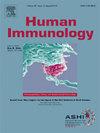Assessing the adequacy of immunosuppression in pediatric liver transplantation with immune Monitoring: Are we there yet?
IF 2.2
4区 医学
Q3 IMMUNOLOGY
引用次数: 0
Abstract
Current approaches used for pediatric liver transplant (LT) surveillance have diagnostic limitations. We used pleximmune™ immune reactivity index (IRI) and anti-HLA donor specific antibody (DSA) to predict the adequacy of immunosuppression (IS) relative to risk of acute cellular rejection (ACR) at 1-year post LT. This is a retrospective chart review of children who underwent LT between January 1, 2016, through December 31, 2020, and had at least one pleximmuneTM measurement performed within 60-days of a liver biopsy. There were 45 liver biopsies with accompanying pleximmuneTM in 31 children. An inverse correlation was observed between tacrolimus level and IRI (R = -0.34; p = 0.039). The sensitivity, specificity, positive and negative predictive values of IRI for diagnosis of ACR was 55 %, 65 %, 33 % and 81 % respectively. The combination of DSA and IRI had a specificity of 92 % and negative predictive value of 89 % for ACR. In conclusion, a high IRI identifies recipients with low tacrolimus levels. Thus, the associations observed in this non-standardized cohort support the use of pleximmuneTM IRI in combination with DSA, for hypothesis generation in future studies involving post liver transplant graft immune surveillance.
在免疫监测下评估儿童肝移植免疫抑制的充分性:我们做到了吗?
目前用于儿童肝移植(LT)监测的方法具有诊断局限性。我们使用pleximmune™免疫反应指数(IRI)和抗hla供体特异性抗体(DSA)来预测LT后1年免疫抑制(IS)相对于急性细胞排斥(ACR)风险的适当性。这是一项回顾性图表回顾,研究对象是2016年1月1日至2020年12月31日期间接受LT治疗的儿童,并且在肝活检后60天内进行了至少一次pleximmuneTM测量。在31例患儿中,有45例肝活检伴丛免疫etm。他克莫司水平与IRI呈负相关(R = -0.34; p = 0.039)。IRI诊断ACR的敏感性为55%,特异性为65%,阳性预测值为33%,阴性预测值为81%。DSA联合IRI对ACR的特异性为92%,阴性预测值为89%。总之,高IRI可识别低他克莫司水平的受体。因此,在这个非标准化队列中观察到的关联支持将pleximmuneTM IRI联合DSA用于未来涉及肝移植后移植物免疫监测的研究中。
本文章由计算机程序翻译,如有差异,请以英文原文为准。
求助全文
约1分钟内获得全文
求助全文
来源期刊

Human Immunology
医学-免疫学
CiteScore
5.40
自引率
7.40%
发文量
107
审稿时长
12 days
期刊介绍:
The journal''s scope includes understanding the genetic and functional mechanisms that distinguish human individuals in their immune responses to allografts, pregnancy, infections or vaccines as well as the immune responses that lead to autoimmunity, allergy or drug hypersensitivity. It also includes examining the distribution of the genes controlling these responses in populations.
Research areas include:
Studies of the genetics, genomics, polymorphism, evolution, and population distribution of immune-related genes
Studies of the expression, structure and function of the products of immune-related genes
Immunogenetics of susceptibility to infectious and autoimmune disease, and allergy
The role of the immune-related genes in hematopoietic stem cell, solid organ, and vascularized composite allograft transplant
Histocompatibility studies including alloantibodies, epitope definition, and T cell alloreactivity
Studies of immunologic tolerance and pregnancy
T cell, B cell, NK and regulatory cell functions, particularly related to subjects within the journal''s scope
Pharmacogenomics and vaccine development in the context of immune-related genes
Human Immunology considers immune-related genes to include those encoding classical and non-classical HLA, KIR, MIC, minor histocompatibility antigens (mHAg), immunoglobulins, TCR, BCR, proteins involved in antigen processing and presentation, complement, Fc receptors, chemokines and cytokines. Other immune-related genes may be considered.
Human Immunology is also interested in bioinformatics of immune-related genes and organizational topics impacting laboratory processes, organ allocation, clinical strategies, and registries related to autoimmunity and transplantation.
 求助内容:
求助内容: 应助结果提醒方式:
应助结果提醒方式:


